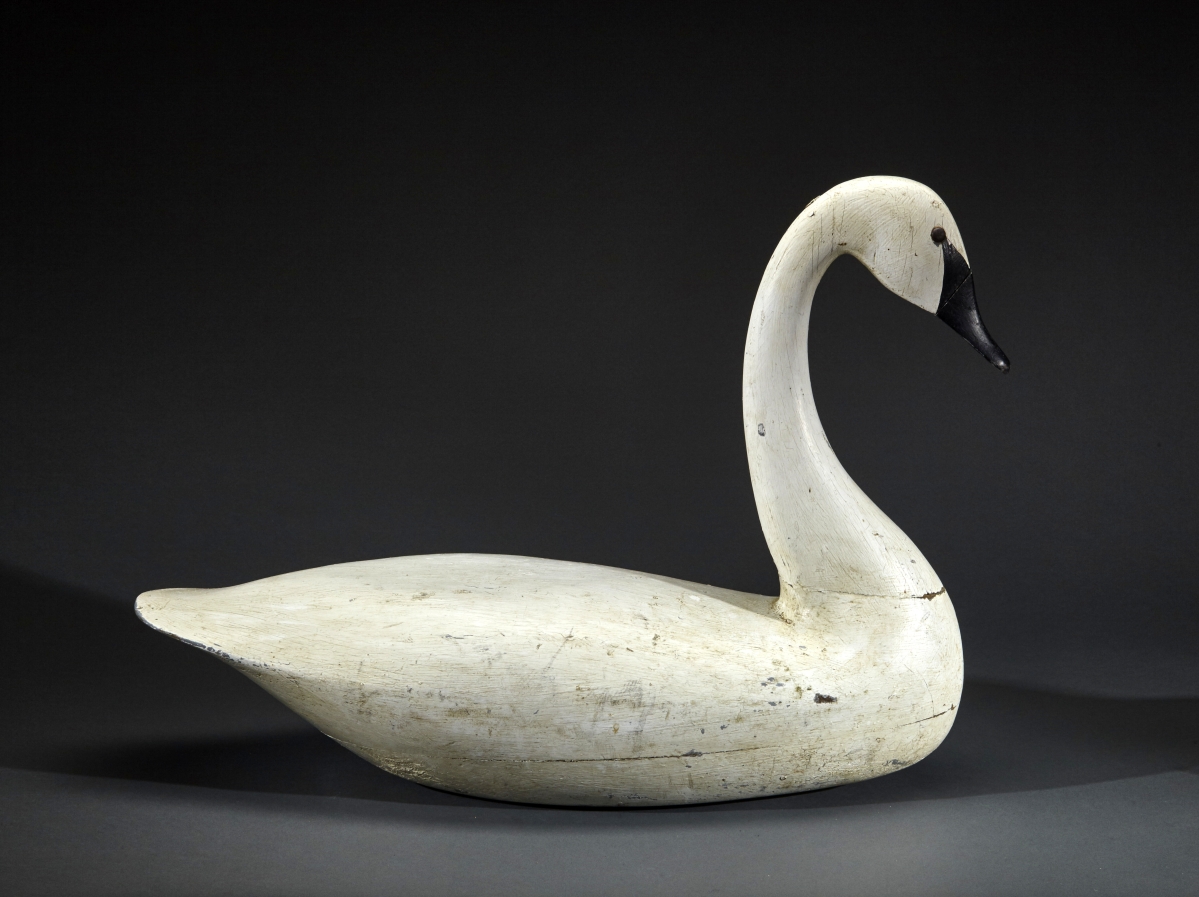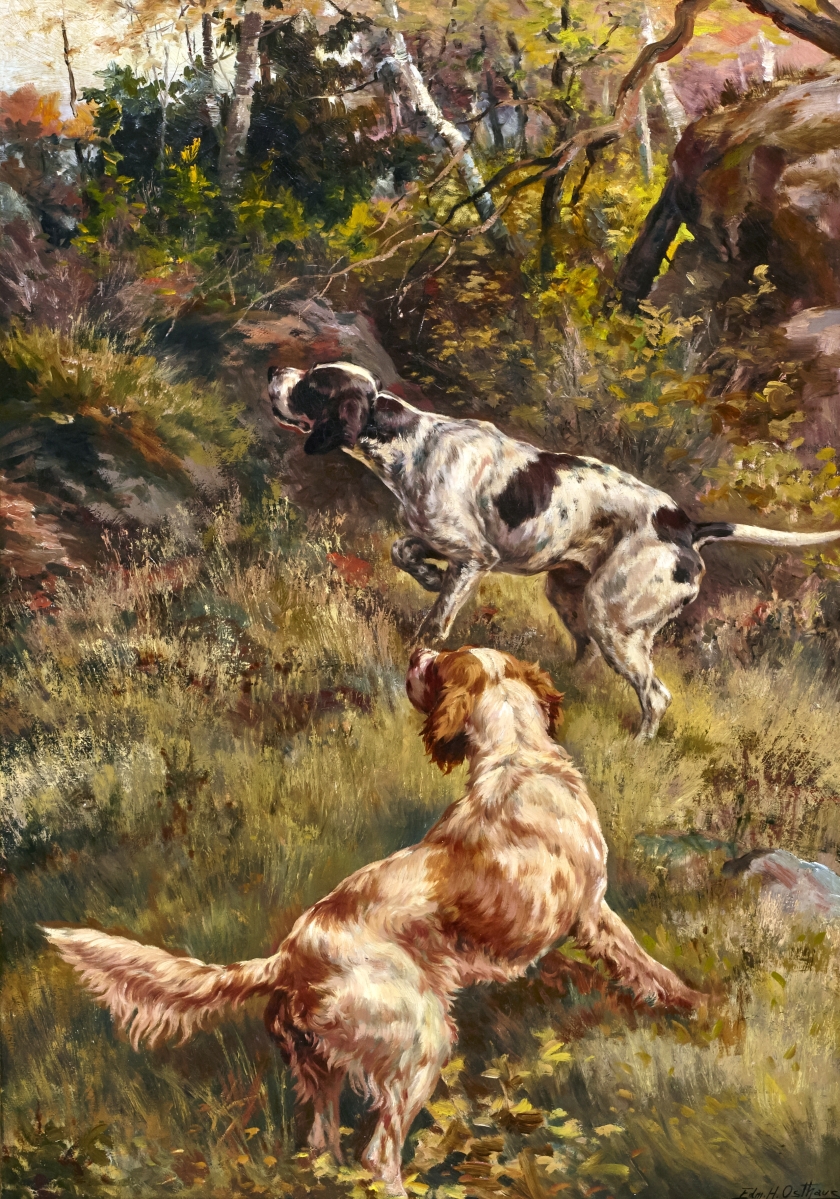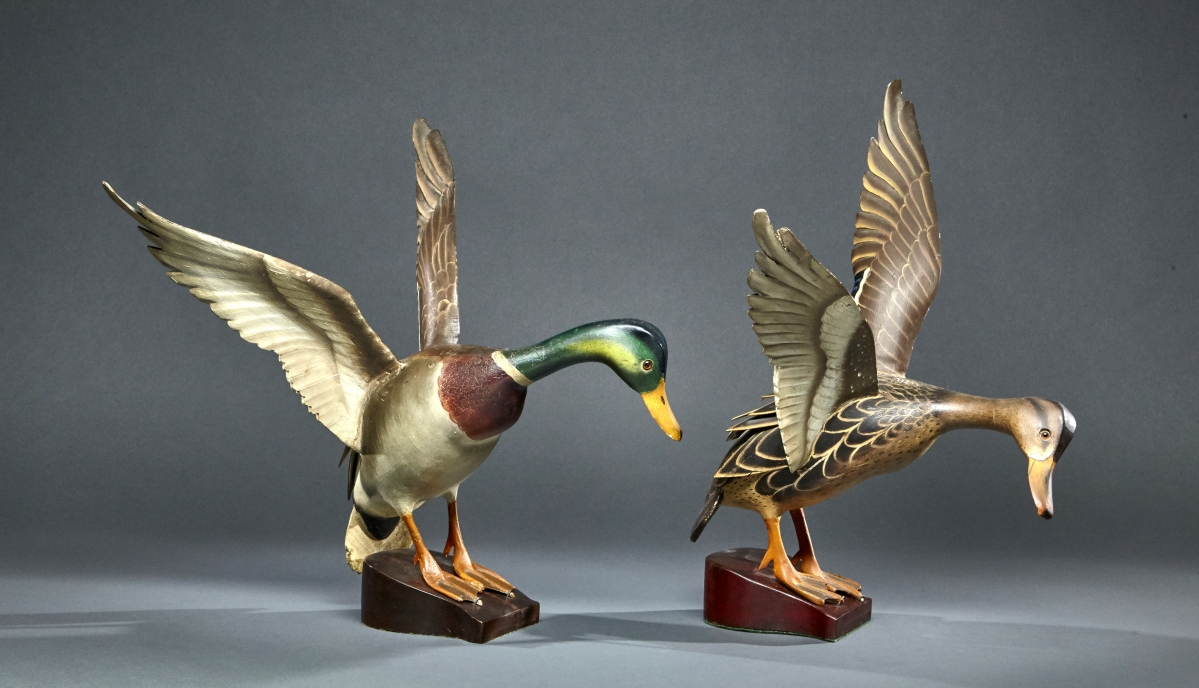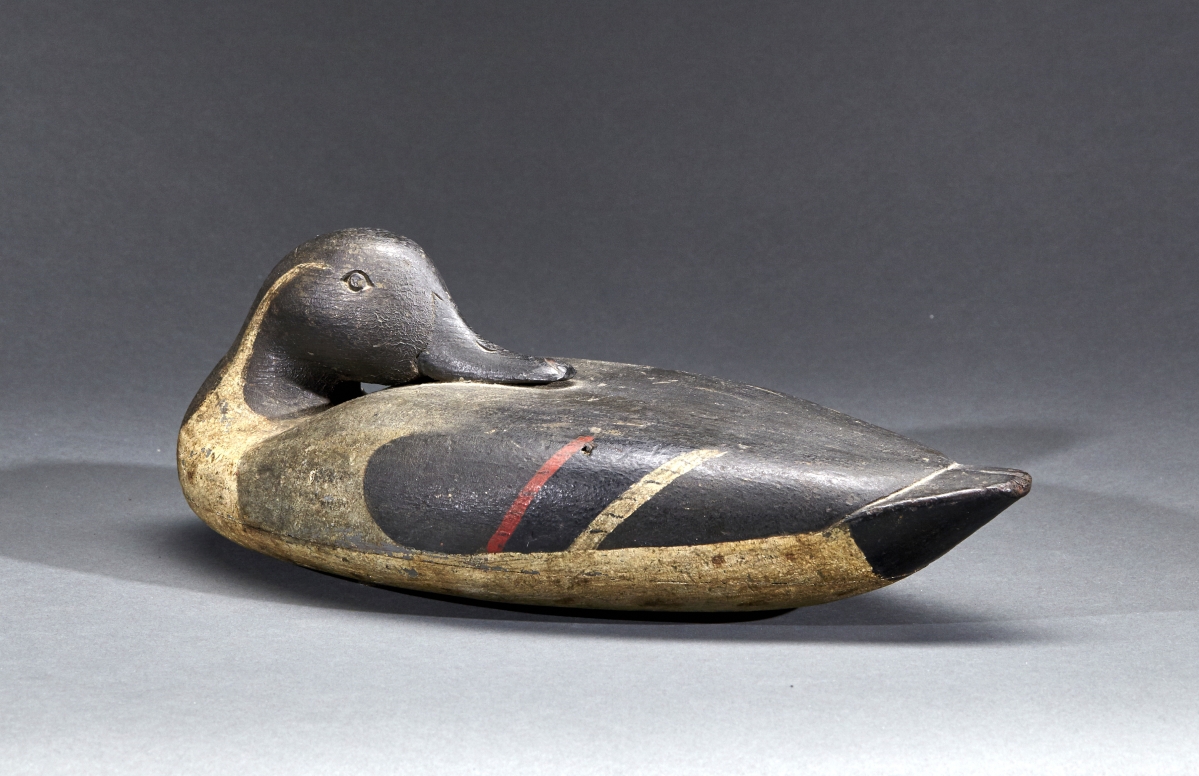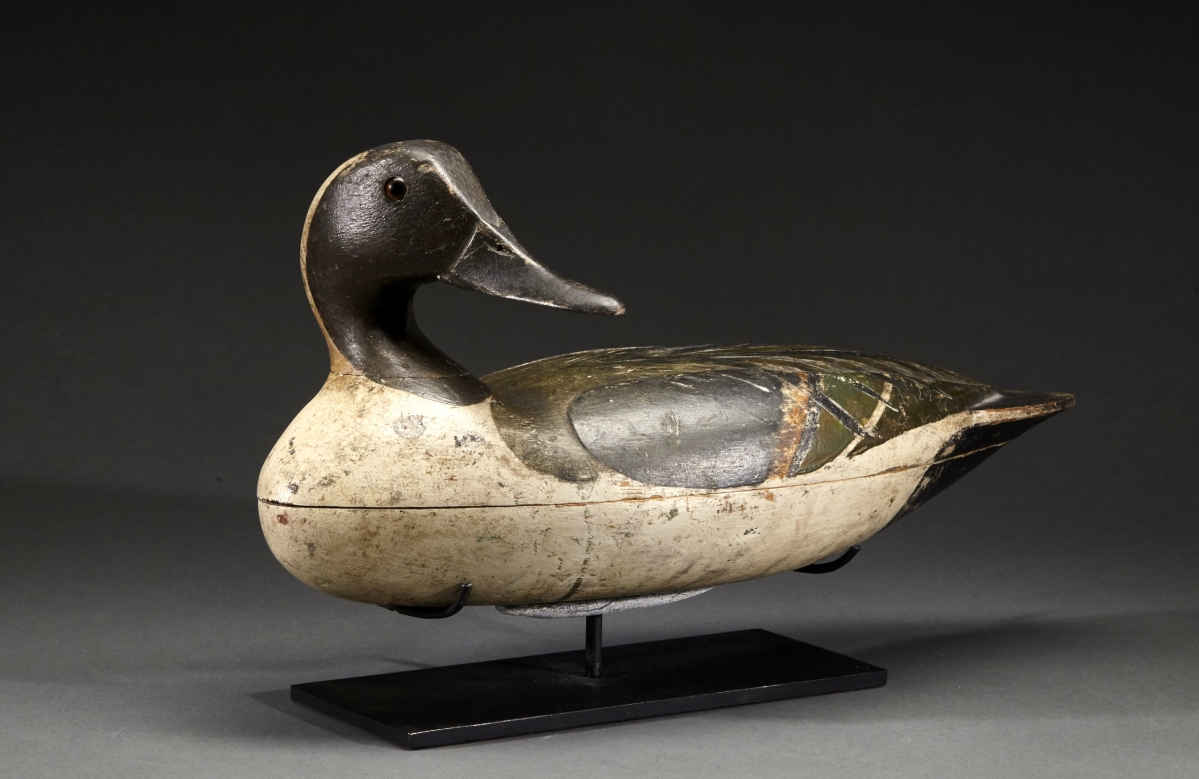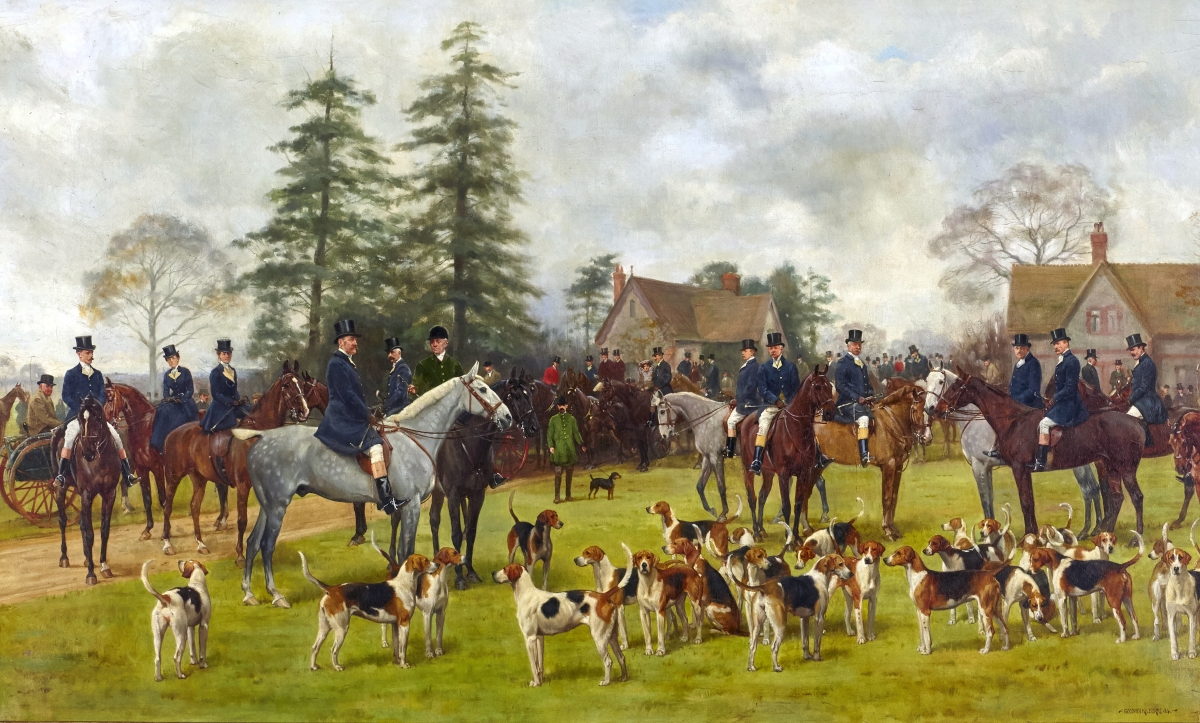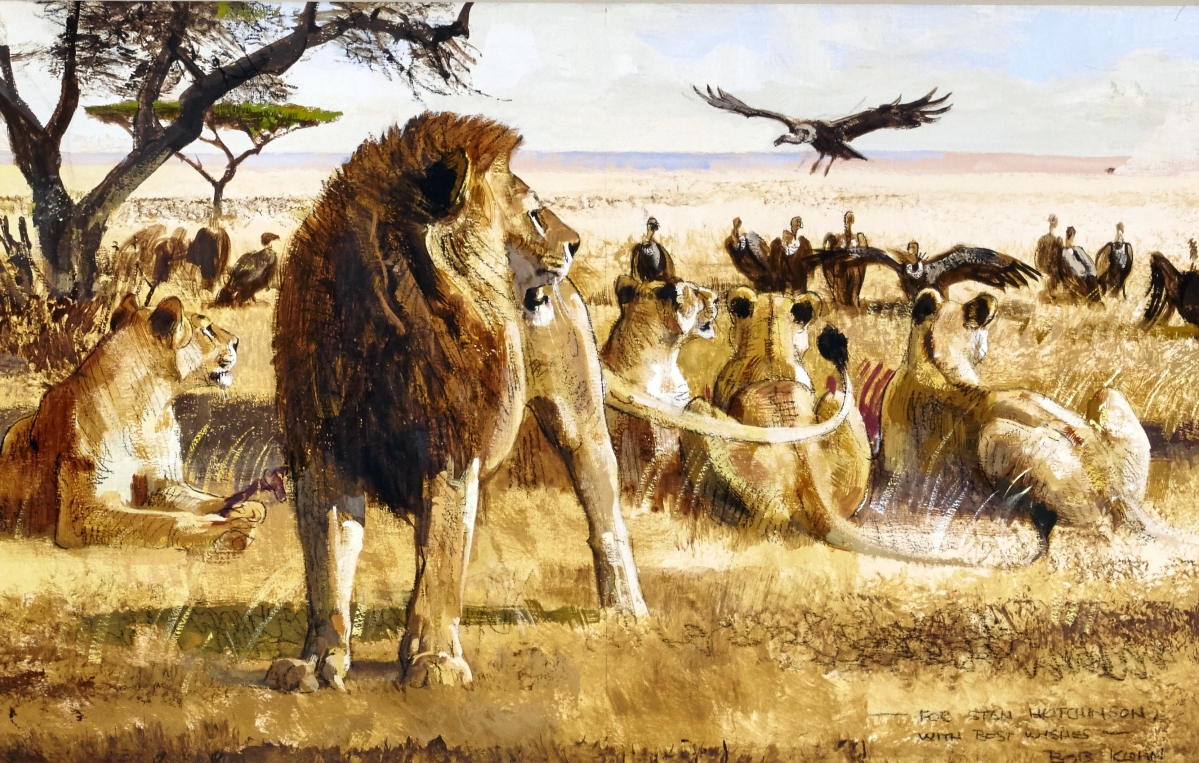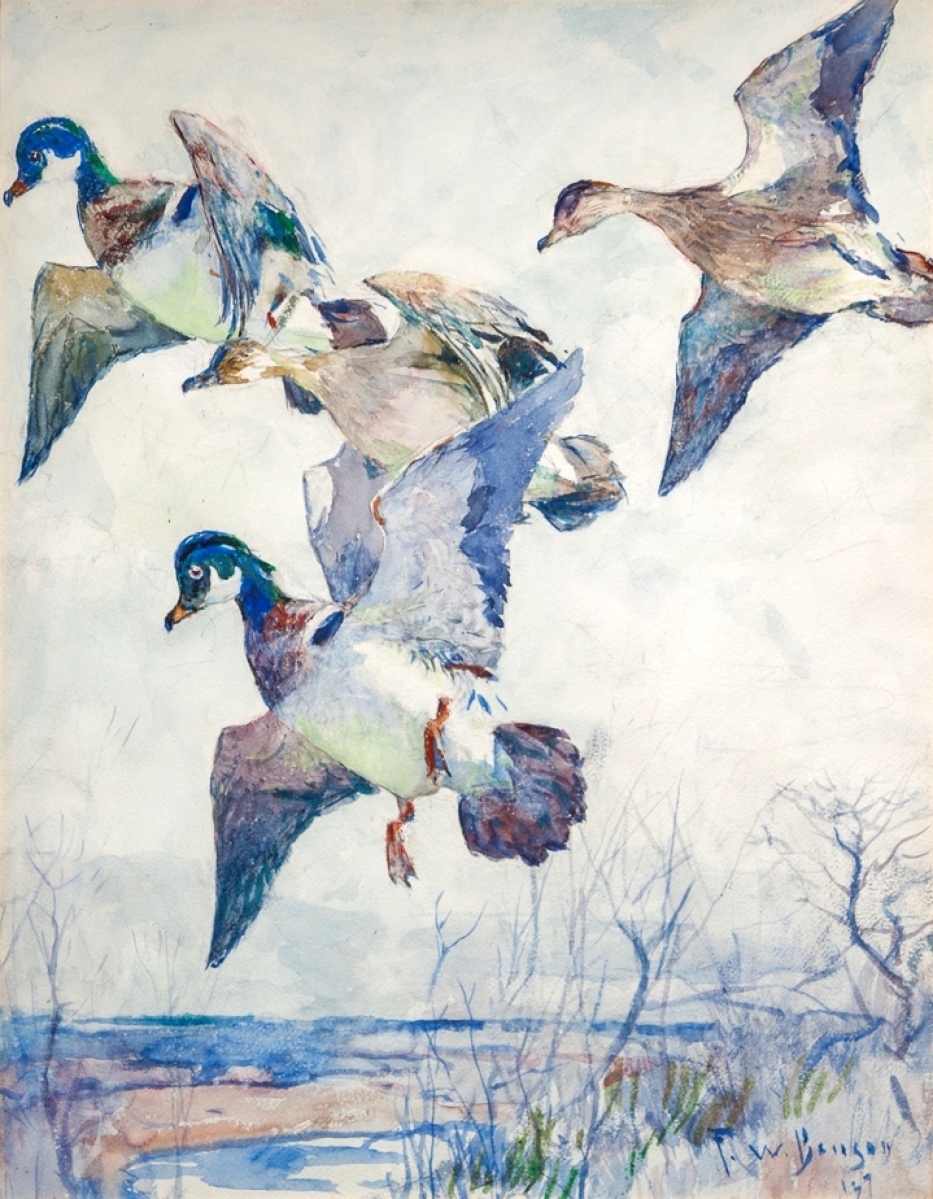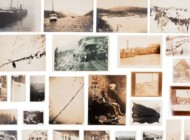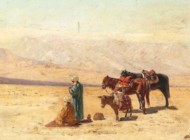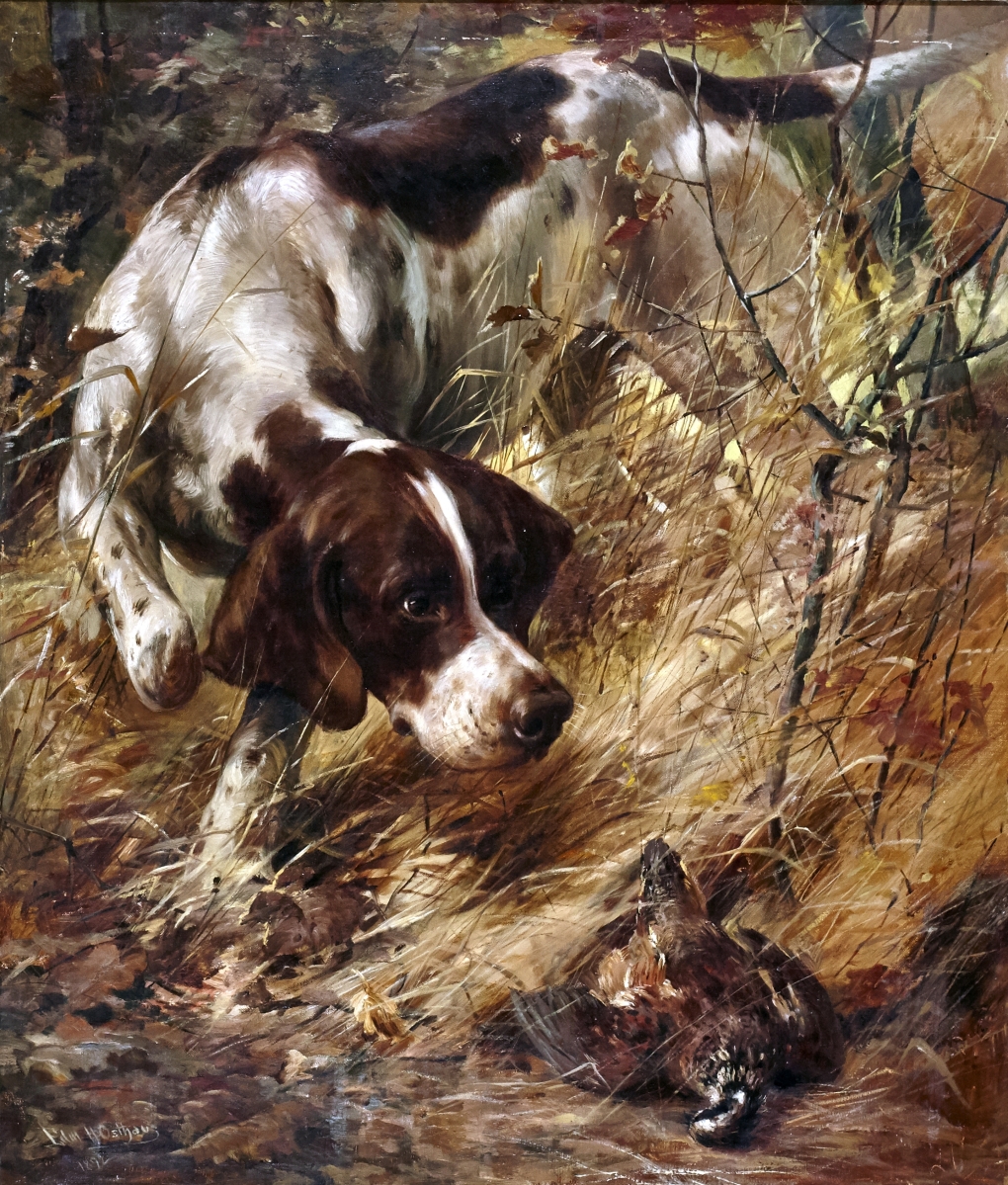
Edmund H. Osthaus (1858-1928), “Pointer and Quail,” 1892, oil on canvas, was the top fine art lot at $63,000.
Review by W.A. Demers, Photos Courtesy Of Copley Fine Art Auctions
CHARLESTON, S.C. – On February 17 at the American Theater in the Design District of Upper King Street, Copley Fine Art Auctions conducted its 2017 Winter Sale, which it characterized as “another great success.” All five cover lots sold realized strong prices – two landing within estimate and three climbing over their estimates – and the auction posted a 91 percent sell-through rate, totaling more than $1.4 million and with sold lots achieving 91 percent of their high estimate.
The firm successfully sold more than 450 items of antique and contemporary decoys and American, sporting and wildlife art. Conducted in conjunction with the Southeastern Wildlife Exposition, the auction is perennially balanced between fine art and decoys, offering a wide range of American, folk, sporting, wildlife and western art. There was robust bidding across all categories, according to the firm, including paintings, prints, folk art and antique and contemporary decoy carvings.
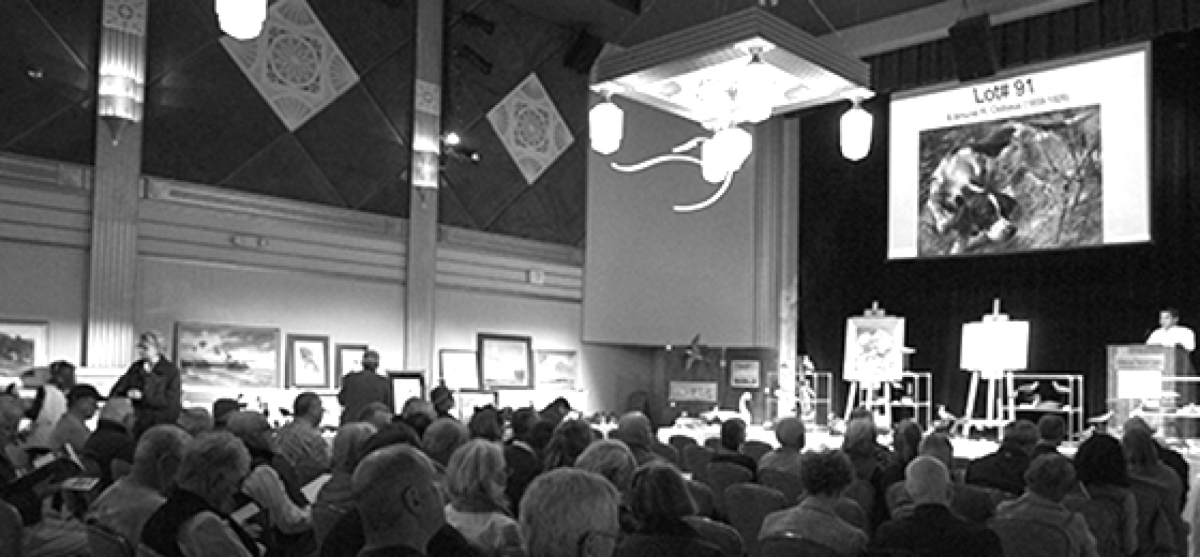
There was robust bidding across all categories at Copley Fine Art’s Winter Sale at the American Theater, including paintings, prints, folk art and antique and contemporary decoy carvings.
“There was no question that broader markets had an impact on this sale,” said Copley’s owner and principal Stephen B. O’Brien Jr. “We saw some of the most competitive bidding in seven years. All facets of the sale were exceptionally strong with the possible exception of the Benson watercolors. Though his ‘Wood Duck’ sold for $37,200, the highest price for any of his watercolors since 2011, it is clear that it is a buyer’s market when it comes to Benson at the moment.”
The top painting was one of two works by Ohio artist Edmund Osthaus crossing the block. “Pointer and Quail,” which sold for $63,000, was followed by Osthaus’s “On Point,” which brought $44,400.
Edmund Henry Osthaus (1858-1928) was born in Hildesheim, Germany, the son of a prosperous farmer who subsequently emigrated to Toledo, Ohio. Osthaus studied at the Royal Academy of the Arts in Dusseldorf from 1874 to 1882, receiving instruction in both wildlife and landscape painting. In 1893, after studying painting for six years, Osthaus became an instructor at the Toledo Academy of Fine Arts. Described as a “handsome, powerfully built man,” Osthaus combined his love of dogs with his artistic talent to successfully capture the essence of a working dog while at the same time succeeding in capturing every anatomical detail.
In 2008, Copley sold the world-record-setting work that is directly related to “Pointer and Quail.” Titled “Pointer with Quail” (in this painting, the quarry is firmly in the dog’s mouth), the 30-by-36-inch oil on canvas sold to a private collector following a protracted phone-bidding war for $230,500. This sale’s work was painted two years after that one, according to catalog notes, and poses the same dog in a vertical format.
“On Point,” the other Osthaus painting that led fine art offerings in the auction, depicts two hunting dogs that have spotted their quarry. One of the setters has brown and white coloring while the other is depicted with orange and white markings, a favorite of the artist, according to catalog notes. The two painting lots revealed that works of hunting dogs in action continue to be in high demand.

Charles Sumner Bunn or William “Bill” Bowman (1865–1952 and 1824–1906), yellowlegs, circa 1900, sold for $90,000.
The top shorebird lot and overall sale leader was the Herrick-Ward yellowlegs from the Grant-Nelson collection, which sold for $90,000. The catalog described it as “one of the finest Bunn/Bowman decoys held in private hands,” adding that the majority of the birds from the storied Herrick collection can be found in the Long Island Museum in Stony Brook, N.Y. Herrick, a sporting art and decoy expert and an ardent waterfowler, once owned the yellowlegs and then it went to dealer Bud Ward. The shorebird was made in the first quarter of Twentieth Century and attributed to William Bowman (1824-1906) and Shinnecock Indian carver Charles Sumner Bunn (1865-1952). Superb form, impeccably painted surface and original bill and wing tips combined to make this shorebird a desirable catch, and indeed it bested its $50/70,000 estimate when a bidding war from numerous factions narrowed down to a phone bidder and a determined gentleman on the floor who was ultimately successful.
Bunn/Bowman are also listed as carver of the McCleery Golden Plover, which brought $69,000, and like the yellowlegs, the 11Â-inch-long bird was a tour-de-force of outstanding original paint. The bird’s underside retained the stamp of the collection of James M. McCleery, MD, which was the focus of an $11 million auction in New York City in 2000, an event that brought worldwide attention to decoys as works of art and established astonishing new levels of value for classic birds. As the McCleery Bunn/Bowman golden plover sold to the same floor bidder, a spontaneous round of applause came from onlookers.
Charles Birch (1867-1956) was a boat-builder, waterman and decoy carver from Willis Wharf, Va. Born in Maryland and raised in Chincoteague, Birch came to Willis Wharf when he was 39, according to catalog notes. He made only a handful of confidence swan decoys. One was featured in this sale, and it was considered to be in the top tier of known examples. It was a hollow swan, with a graceful, turned-down head and a long, slender neck. Features included an inserted oak bill, tack eyes and a raised neck seat. Fetching $60,000, the swan had provenance to the founder of the Gooseville Gun Club in Hatteras, N.C., George Albert Lyon (1882-1961), an industrialist and sportsman.
Other top shorebird results included the Noah Bernard Sterling wading greater yellowlegs pair, which brought $27,600, and Ira D. Hudson’s greater yellowlegs, originally out of the William H. Purnell Jr collection, which brought $19,200. These landed within or above their estimates.
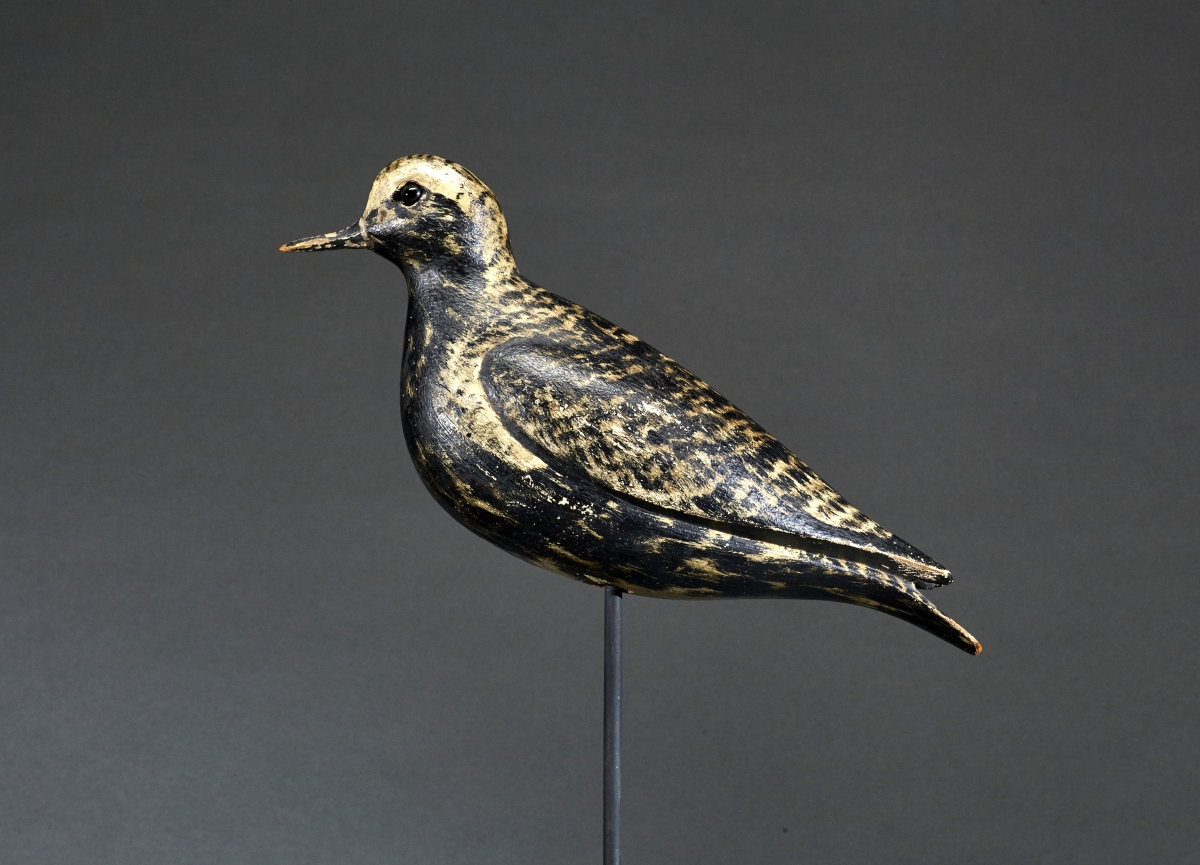
Charles Sumner Bunn or William “Bill” Bowman (1865–1952 and 1824–1906), the McCleery Bunn/Bowman Golden Plover, circa 1900, realized $69,000.
The Ward Brothers’ life-size flying mallard pair brought $36,000. Also by the Ward Brothers, a bluebill pair came in above the high estimate at $9,600. A. Elmer Crowell’s rare willet sold for $15,600. Two A.G. Fox rig plovers soared above their high estimates of $2,500, with one bringing $5,400 and the other $3,900, while a James “Corb” Reed widgeon drake came in at $1,800, well over its $800-$1,000 estimate.
Richard Wistar Davids’ early sleeping pintail drake pitted floor bidders against five phones, and ultimately went to a bidder in the room for $30,000, surpassing the high estimate of $25,000 and setting a new world record for the maker. Crowell’s miniature wood duck, though a later model, saw vigorous floor, phone and internet bidding and went to a floor bidder for $1,920. A preening canvasback drake by Charles Ralph Wells saw a moment of levity as O’Brien tried to go the wrong way with bidding. Ultimately this lot brought $1,920, well over the high estimate.
There was solid interest in contemporary carver Mark S. McNair’s works, many of which sold to internet bidders. A shoveler drake went for $2,400 and a ruddy duck sold for $1,353. Both lots were above their high estimates. Works by William Gibian also received strong interest across all bidding platforms, as lots were won by three different phone bidders and each exceeded its high estimate. Anthony G. Murray’s two pintail pairs brought in $2,040 and soared above the high estimate of $1,200.
A turned-head Carriage House pintail drake was one of the top selling decoys, bringing in $28,800 and soaring past the high estimate of $20,000. Charles S. Schoenheider Sr’s standing hollow pintail drake performed well and sold for $28,800, landing between the estimates for this decoy. John Macanney’s ruddy turnstone more than doubled its high estimate of $5,000 and realized $10,800. William Roberts’ ruddy turnstone also exceeded the high estimate of $1,500 and sold for $2,400.
A wide selection of prints from the Ernest and Carolyn Kramer collection were on offer. After close to 50 years of collecting and 35 years in business, the Kramers decided to retire and give collectors the opportunity to acquire examples of sporting art by Frank W. Benson (1862-1951), as well as works by many other Twentieth Century printmakers. Twenty-two rare and collectible Benson etchings comprised this portion of the sale, and, as previously mentioned, the artist’s “Wood Duck,” 1937, a watercolor, flew the highest at $37,200. The image, depicting four birds in various attitudes of flight against a pale winter sky, was the frontispiece for Concord River, a collection of excerpts from the diaries and field notes of ornithologist William Brewster.
A selection of John Henry Dick watercolors from a private collection in Virginia got the auction off to a strong start. A work depicting painted redstarts and warblers more than tripled the high estimate when it sold for $2,520 on a $600 estimate, as did a painting of olive warblers with a butterfly, which sold for $2,280 on a $600 high estimate. Several lots later, four shorebird pen and ink drawings brought $1,800, well over their high estimate of $400.
An English fox hunting scene by George Goodwin Kilburne saw very active bidding on the phones and internet. Kilburne’s oil painting titled “The Beaufort Meeting at Frocester,” which dates from 1904 and depicts one of the oldest and most famous hunts in the United Kingdom, sold for $32,400, more than quadrupling its high estimate of $6,000.
“Oystercatchers,” a commanding, semi-abstract oil on canvas by Ewoud de Groot, shot past the high estimate of $10,000 and sold for $13,200, setting a world record at auction for the contemporary Dutch artist. While Frank E. Schoonover’s “Trappers on the Lake” received attention, it did not find a buyer with the $100/150,000 estimate, as perhaps the interested parties found the estimate a bit aggressive.
Anders Leonard Zorn’s etching titled “Augustus Saint Gaudens II” surpassed its high estimate of $6,000, bringing $7,200. Early American artist Frederick Stone Batcheller’s oil painting of woodcock and quail brought $7,380, and noted wildlife artist Bob Kuhn’s little gem depicting lions sold for $19,200.
“Tails,” an oil painting by Bonefish & Tarpon Trust’s (BTT) 2017 Artist of the Year John Swan, brought an impressive $12,000. Once again, proceeds from the sale will benefit this conservation organization. A generous anonymous donor agreed to a matching gift of up to $10,000 on this work. The funds generated from the sale of this painting will fund much-needed research on bonefish, tarpon and permit, along with their sensitive ecosystems.
O’Brien, who is also a BTT board member and avid tarpon and bonefish angler, added, “We are indebted to John Swan for producing an exceptional work that the market responded to. This is one of the highest totals that a BTT Artist of the Year work has brought in its ten-year history.”
Works by other contemporary sporting artists also sold well, with Brett J. Smith’s oil painting “One Step Pool” bringing $10,200, nearly double the high estimate of $5,500, and Thomas Aquinas Daly’s watercolor “Casting at West Falls Pool” fetched $5,843, well over its high estimate of $3,000. This was the second highest price for a Daly watercolor after the world record Copley set in 2012 for the artist. Gary E. Neel’s painting of a pheasant set a record for a single watercolor by the artist, selling at $1,200.
Paintings and bronzes from the estate of Joyce and Larry Huffman, founder of Legendary Whitetails, the American sporting clothing company, were 100 percent sold by lot. Bronzes overall held strong, as David LeRoy Schaefer’s “Eagle Catching a Fish” brought $1,500, well over the high estimate of $900. A pair of hunting dog bookends, after French artist Jules Moigniez and stamped “Tiffany and Co.,” went over the high estimate of $2,500 and sold for $3,690. Marilyn Newmark’s diminutive pony bronze, “First Meeting,” rang in at $1,140.
Fishing items, particularly fly rods, exceeded estimates. Two H.L. Leonard rods sold for more than five times the high estimate of $600, bringing in $3,300. An E.F. Payne Rod Co. bamboo fly rod realized $2,520, more than double its high estimate of $1,200.
Additionally, Canadian carver and fisherman Thomas Brayshaw’s fish carvings performed well, with a “priest” carving of a brown trout bringing $1,800, double its high estimate of $900, and his steelhead trout carving selling for $8,100.
After more than 200 fine art and fishing lots had crossed the block, auctioneer Peter Coccoluto continued straight on to decoys without a break. A desirable offering of miniatures got off to a strong start as the auction room remained full, with action coming from phones, floor bidding and internet platforms. The second session began with a collection of George H. Boyd miniature carvings performing within or above their estimates, including a black duck pair that sold for $3,900 and a Lincoln wood duck that brought $2,160.
A selection of miniature carvings by Maine maker Robert Morse saw steady interest. A purple finch sold for $1,680, surpassing the high estimate of $600 by more than double, a blue jay also more than doubled its high estimate of $600, bringing in $1,320, and a cardinal doubled the high estimate and brought $1,200. A miniature downy woodpecker saw active bidding between the floor, internet and phone bidders. The carving ultimately sold for $960, above its high estimate of $600.
The sale featured items from the collections of Richard and Lynn Gove, the estate of Joyce and Larry Huffman, Ernest and Carolyn Kramer, Blair Ledingham, Grant Nelson, Shane Newell, John T. Ordeman, William H. Purnell Jr, and William B. Webster III.
Prices reported include the buyer’s premium.
Copley is now accepting consignments through April 15 for its sporting sale, which returns to Plymouth, Mass., in late July. For information, 617-536-0030 or www.copleyart.com.

